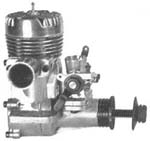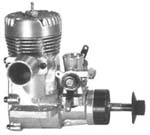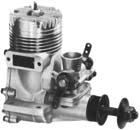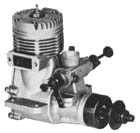
Evolution of the
.40, .45, .50 & .46ABC B-Frame Engine Series
In the early 70's Duke Fox began
hinting at a revolutionary new series of .40 and .45 size engines.
Boasting outrageous power output along with several new "tricks"
never seen before, these engines were to be a radical departure
from previous Fox's. Fox fans waited anxiously wondering what
lay behind the silhouette line drawings depicted in those early
Fox advertising brochures. Finally, in 1975 the new engines were
unveiled and truly were a radical departure from previous Fox's.
The unusual crankcase design incorporated what Fox called the
"high back door" rear cover that "allowed the
bypass cores to be made to dimensions dictated by best performance,
not manufacturing limitations". The new engines also incorporated
the latest (for the day) Schnuerle porting technology and they
did deliver on the promise of more power typically turning 1-2,000rpm
higher than most engines of similar displacement. When we first
started using these ourselves we were amazed at the brute power
they delivered. Duke had claimed the .45 was as powerful as many
.60's of that period, and we would tend to agree.


Early Bushing Version |


Early Ball Bearing Version |
Both .40 and .45 engines were
originally offered in plain bushed and ball bearing versions.
The bushed engines utilized the old tried and true combination
of a mehanite piston and leaded steel liner, while the ball bearing
versions were supplied with ringed aluminum pistons running in
a carbonitrided liner. Another unique feature was the round exhaust
stack which, according to advertisements, was "designed
with the thought in mind that a soft aluminum exhaust extension
could be readily fitted into it and could be bent around in a
manner most convenient for the airplane builder".


Restyled for 1977
and has changed little since |
The next significant
change for this engine series came in 1977. The exterior was
restyled with turned down fins and glass bead casting finish.
The mehanite piston in the bushing .40 was made lighter while
the piston in the bushing .45 was replaced an aluminum one to
cure vibration problems. The head design was improved with a
separate machined head button which added 400-500rpm. The round
exhaust stack also disappeared and new conventional mufflers
were made available. |
Somewhere between
1979 and the early 1980's, the bushing models were discontinued
and only the ball bearing models with ringed aluminum pistons
remained in production. In 1980 the more conventional MKX series
two-needle carburetor was introduced - a major step forward for
Fox RC engines. Unfortunately, right around the same time Duke
began his obsession with extracting performance from FAI fuel
thus negating some of the benefits of the new carburetor. |


New MKX carburetor in 1980 |
The unusual, high compression
head button design made engines more finicky to run and adjust
and this was often, but wrongly, blamed on the carburetor. In
our opinion, this was a major mistake on Duke's part. The new
carburetor, along with a head design optimized for the 10-15%
nitro sport fuels that most of us prefer to use, would have resulted
in many more sales and many new Fox converts. While the .40 and
.45 typically did not experience quite the degree of problems
exhibited by the larger Eagle .60, they could have been so much
better with a more conventional head button design.
In 1983 the smaller C-frame .40
was introduced, and both large and small frame .40's were produced
for a time. However, with the smaller, lighter .40 producing
about the same power, it wasn't long before the large frame .40
was discontinued. The .45 remained in production and in 1987
received another internal makeover. The wrist and crank pins
were made larger and the wrist pin was lowered in the piston
for improved side load distribution.
1987 also saw another significant
development with the introduction of a bored out version of the
.45 bringing the displacement up to .50. The new .50BB had the
same bore as the Eagle .60 and even used the same ring, although
the piston was somewhat different. A light and powerful engine
with great potential, but again often suffered running and reliability
problems because of the high compression head button design,
especially the earlier versions. For more detailed information
on the .50BB click here.
February of 1991 was a sad time
for Fox enthusiasts with the passing of Duke Fox. And while his
wife, Betty, and the dedicated staff at Fox Mfg. continued production,
there would be no new developments for a few years until Charles
Thacker came on board as chief engineer. Not long after, a new
.46ABC engine was introduced using the same frame as the .45
and .50, along with a new "EZ" series carburetor. With
the introduction of the smooth running and more powerful .46ABC,
the .50BB was soon discontinued. The EZ series carburetor was
a bit of a mixed blessing, however. While offering ease of adjustment,
the fixed midrange metering system also had some drawbacks. For
more information on EZ series carburetors, click
here.
The .45BB and .46ABC remain in
production to this day with no further significant changes. At
one time Charles had been working on a new two-needle carburetor
but, it would seem, development on the older 2-stroke engines
has been overshadowed by the new gas engine series Fox has recently
introduced. |